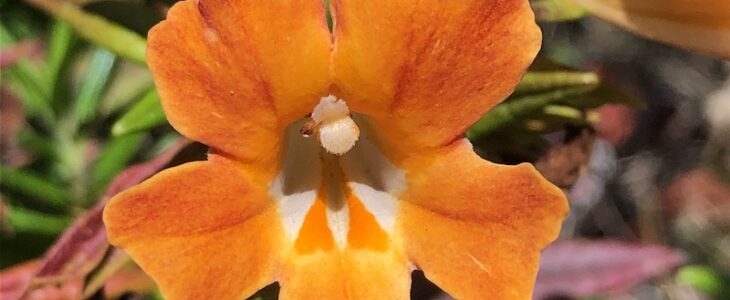
Sticky or bush monkeyflower Diplacus aurantiacus is so common in our area that most of the time, we barely notice it. But this time of year, when the kaleidoscope of spring has begun to settle its relentless color shift the monkeyflower provides a bit of warm sparkle. Most commonly seen in coastal scrub, it also grows in chaparral, oak woodlands and mixed evergreen forests. Naturally occurring populations occupy a variety of habitats from full sun blasted rocky slopes to the dappled shade beneath oaks and conifers.
Known to many as a Mimulus, sticky monkeyflower was until recently classified in the formerly large figwort or snapdragon family. With the illumination of genetic differences, the figwort family got split up. What was familiar and observable to the eye got reclassified according to genetic evidence. Our woody monkey flowers were placed in their own genus Diplacus in the Phrymaceae or Lopseed family. Many of the other well known plants with snapdragon like flowers got placed in the Plantaginaceae or plantain family. As to the common name, someone somewhere along the way saw the two lobes at the top of the flower tube as monkey ears. To my eye it could just as easily be called sticky bunny or bush bearflower.
The flower tube or corolla is formed by 5 fused petals. The lobes, two on top and three on bottom, are often deeply notched or fringed. When healthy, this exuberant shrub blooms prolifically from late winter through mid-summer. The throat of the flower displays prominent nectar guides, often in a different color, as a visual aid for pollinators. The flower color of the wild type is in the light yellow to light orange range. Evergreen, sticky, lance shaped leaves with in-rolled margins line brittle stems. It can range in size from 1 to 4 feet tall by as wide. Depending upon individual gene expression and cultural conditions monkeyflower can be upright, mounded, or sprawling.
Bush monkeyflower is not fussy about soil type but, good drainage is essential. Well adapted to our arid western climate, this member of the local flora goes into a semi-dormant state as the soil dries up. If your plant is on irrigation, be sure to taper and turn off the water allowing it to follow its normal cycle of summer dormancy. Continuous summer water will encourage root-rotting pathogens which will eventually kill the plant. For a tidy appearance, once it is done blooming, prune back the stem ends leaving a few inches of the current year’s wood. This has the added benefit of stimulating vigorous new shoots the following season. During the active growth phase, pinching rangy stems also promotes strong, dense growth.
Diplacus aurantiacus hybridizes readily, creating both naturally occurring as well as intentionally derived crosses. Sticky monkeyflower has a neat trick of quickly closing its two-part stigma when touched. Somehow the stigma senses if the touch contained pollen. If pollen was introduced the stigma stays closed, if no pollen was introduced it reopens. A helpful sign for horticulturalists doing cross breeding. In the nursery trade, hybrids include a wide range of flower colors, bi-colors, flower size and frilliness. Hybrid flower colors range from snow-white to bright yellows, shades of orange, fire-engine red, through burgundy, and even pink.
In these first weeks of summer bush monkeyflower continues to bloom even though many of the other flowering plants are done showing off. In grassland areas the perennial bunch grasses have flowered and dropped their seed. Later blooming California fuchsia, goldenrod and aster are just beginning to show themselves. The summer swing of things is always entertaining. Last week while camping I watched a pair of Vireos feed with a clear view of the nest and then got to witness the heart in throat moments of fledglings taking to the wing. On the last day of my visit, I happened to be standing still looking at the creek when a black bear with tawny highlights exited a willow thicket across the broad channel, sniffed the air, looked around a bit and then moseyed on down-stream.
Happy Summer!